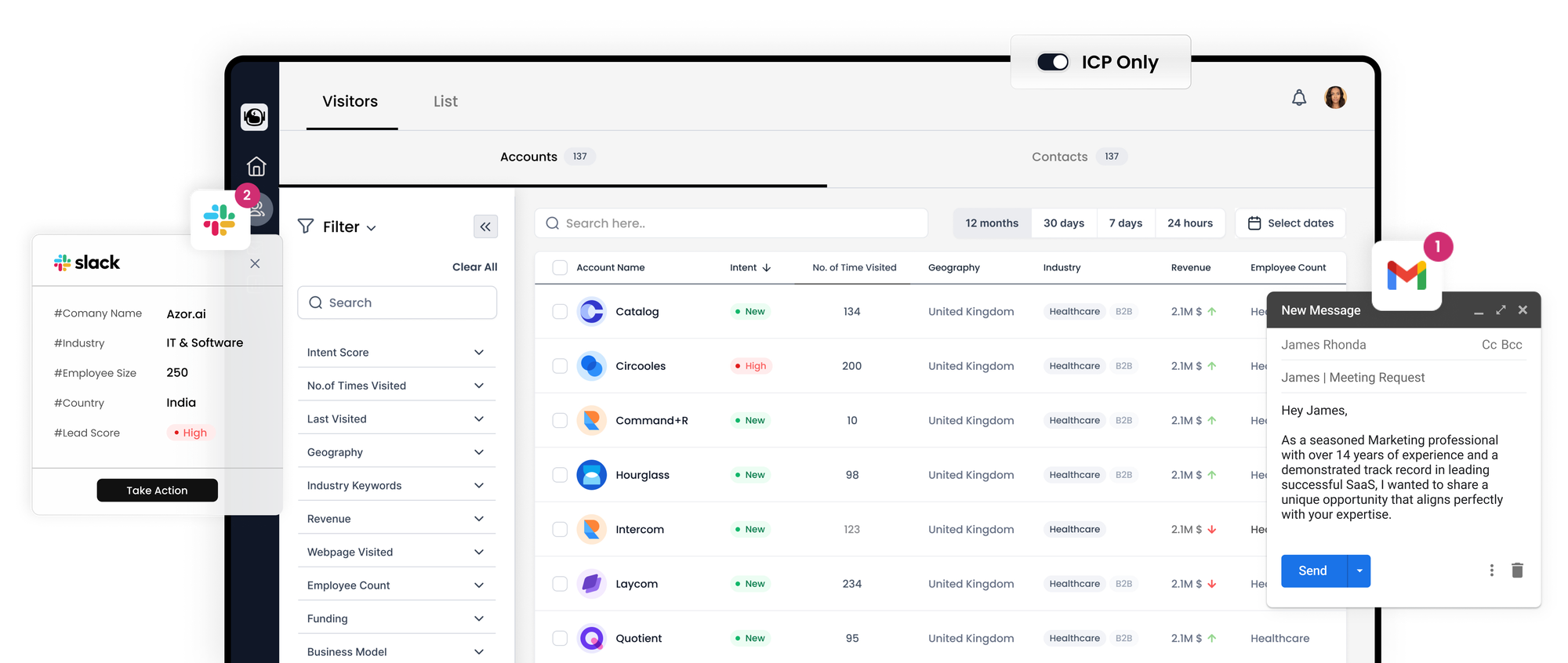Comprehensive Guide to Web Visitor Tracking

For sales and marketing professionals, understanding your potential customers is paramount for executing targeted actions that can attract and convert high-quality leads. Web visitor tracking is a powerful tool that provides valuable insights into the individuals engaging with your website. It not only reveals where and how visitors are navigating your site but also offers the ability to identify these visitors on a personal level.
In this concise introductory guide, we aim to address the fundamental aspects of web visitor tracking. This includes defining what web visitor tracking entails, explaining its benefits, and ensuring compliance with relevant rules and regulations. Additionally, we explore the advantages of utilizing a dedicated tool, which can enhance your sales outcomes beyond what platforms like Google Analytics can achieve on their own.

What is Web Visitor Tracking?
Web visitor tracking is a multifaceted process that serves two primary purposes. Firstly, it involves analyzing the activities and behaviors of visitors on your website. Secondly, it allows you to pinpoint individual users and identify the companies they represent. This tracking encompasses various aspects, including:
- Monitoring web and landing page views.
- Tracking video interactions.
- Analyzing clicks on links, sales pricing, and promotional offers.
With the assistance of tools, you can not only track the companies visiting your site but also access contact information for relevant individuals within those organizations. By associating the people interacting with your site with their respective companies, you can develop comprehensive lead and customer profiles, expanding the reach of your sales and marketing efforts.
How Can Web Visitor Tracking Benefit You?
Dedicated web visitor tracking offers a level of contact detail that is challenging to attain through broader analytics programs like Google Analytics. This level of contact data provides several benefits:
1. Identify Interested Parties
Understanding which companies visit your site, the sources of your web traffic, and user behavior allows you to create more targeted content and campaigns, enhancing the overall user experience.
2. Attract and Convert High-Quality Leads
With an optimized website and behavioral insights into your audience, you can spend less time searching for new leads and more time engaging with potential customers who are already expressing interest.
Web visitor tracking tool, for instance, empowers you to:
- Identify companies within your website traffic that were previously unidentified or unconverted.
- Determine how these companies discovered your site.
- Assess their engagement with your content, interests, and time spent on your site.
These insights enable you to fine-tune your content and tailor your outreach efforts, whether to new leads or existing customers. By identifying the names of visiting companies and decision-makers who are actively engaging with your content and campaigns, you can uncover new segments, generate leads you weren't aware of, and anticipate their needs before initiating contact.
Expanding Your Reach with Web Visitor Tracking
According to our State of Sales Report 2020-2021, 51% of sales professionals face challenges in finding sales leads. While Google Analytics provides valuable information about website visitors, it falls short in identifying and reaching out to these prospects. Web visitor tracking takes your analysis beyond page views and bounce rates, offering comprehensive user data to construct a cohesive, revenue-generating engine that accelerates sales growth.
Here's how it works:
- Utilize the aggregated data and metrics collected through user tracking to determine which content attracts top prospects, how they discover your website, and which marketing campaigns yield the most success.
- Transform visitors from specific companies into warm sales leads, reducing the need for cold calling or emailing.
- Leverage insights about your ideal customers to enhance both digital marketing and sales activities.
By establishing an efficient feedback loop, you can leverage web visitor tracking software to convert more visitors into leads and turn sales data into engaging web content. The best part is that you don't need to be a tech expert to harness the benefits of web analytics tools effectively.
Comprehensive Guide to Understanding and Utilizing Web Visitor Tracking
For sales and marketing professionals, gaining deep insights into potential customers is pivotal in tailoring effective strategies to attract and convert qualified leads. Web visitor tracking is a potent tool that provides valuable information about individuals interacting with your website. It not only reveals how visitors engage with your site but also offers the capability to identify these visitors on a personal level.
In this concise guide, we explore the intricacies of web visitor tracking, shedding light on its operation, advantages, and compliance with regulations. Additionally, we delve into the value of integrating a dedicated solution into your analytics toolkit, enhancing your sales outcomes beyond what platforms like Google Analytics can achieve alone.
How Does Web Visitor Tracking Operate?
Web visitor tracking integrations typically function in one of two ways:
1. Script Installation
Some solutions entail the installation of a simple script on your website, operating discreetly to interpret visitor click actions and directly collect data.
2. Google Analytics Sync
Others synchronize with Google Analytics, enabling you to extract relevant data from this platform.
Regardless of the method, web visitor tracking goes beyond unveiling the identities of companies browsing your website. It augments data by incorporating publicly accessible contact details such as physical and website addresses.
To grasp the mechanics of web visitor tracking, consider the following key points:
- Every device connected to the internet possesses an IP (Internet Protocol) address, serving as a numerical label for user identification and location.
- Web visitor tracking employs a process called reverse DNS (Domain Name System) to translate these numerical IP addresses into the names of the companies visiting your website.
To illustrate this process further, imagine using the internet to search for a client's or business's phone number. Now, reverse the scenario and envision using a phone number to identify the client or business it belongs to. This is analogous to what reverse DNS accomplishes, but it employs an IP address instead of a phone number to identify your web visitors.
Web visitor tracking technology is invaluable for sales and marketing professionals seeking to engage with customers, especially in the current digital sales landscape. Recent sales trends indicate that 47% of sales professionals anticipate increased seller engagement as digital selling gains prominence.
This is an opportune moment to harness website analytics to:
- Enhance customer journeys and experiences by gaining deeper insights into prospects across various industries.
- Identify heat maps on your website to discern what is effective and what requires improvement.
- Boost conversion rates by understanding which website visitors are more likely to transition into buyers.
Can Google Analytics Alone Suffice?
Sales and marketing teams often rely on the wealth of data provided by Google Analytics to assess website performance and traffic. While Google's platform offers robust features, it falls short in terms of identification compared to what web visitor tracking can provide.
For optimal results, it is advisable to combine data from Google Analytics with that of a dedicated web visitor tracking tool. Employing a specialized integration to track visitors unveils valuable information about website visitors that may not be readily accessible through Google Analytics alone.
Google Analytics, even though it offers a free plan, has limitations that can affect sales initiatives:
- The data sampling technique employed by the free version of Google Analytics can potentially distort results in certain reports.
- Google's platform may not effectively detect and filter out bots and spam traffic, potentially skewing analytics.
- Without an additional third-party service or add-on, Google Analytics may only reveal the name of the hosting or internet service provider used by website visitors, making it challenging to identify specific companies or prospects.
To combat these limitations, combining web visitor tracking with Google Analytics is a strategic approach. Together, these tools offer a robust solution to elevate marketing and sales strategies to new heights.
By integrating these tools, you can:
- Develop precise customer personas and purchase journey maps.
- Enhance SEO and content strategies while monitoring the performance of social media and sales campaigns.
- Facilitate warmer lead generation, capitalizing on the influx of suitable prospects to your website.
Once your marketing efforts successfully attract the right prospects to your website, you can take actionable steps to incorporate them into your sales pipeline. This includes identifying and creating new organizations within your CRM, tracking evolving interest through website visits and session recordings, and delivering personalized sales messages at opportune moments.
The State of Sales 2020-2021 Report underscores the importance of lead generation technology in sales success. It reveals that 63% of survey respondents are utilizing technology or automation tools to source leads, marking a 12% increase from the previous year, partly due to the shift to remote work brought about by COVID-19.
Is Web Visitor Tracking Data Compliant?
Data compliance laws, such as the EU's GDPR (General Data Protection Regulation), Canada's CASL (Canadian Anti-Spam Legislation), and the CAN-SPAM Act in the US, dictate how customer data must be processed and protected. These regulations also establish guidelines for marketing communications and specify penalties for non-compliance.
While these rules and regulations concerning personal data processing also apply to B2B companies, the GDPR permits marketing activities like cold calling and cold emailing if legitimate interest can be demonstrated. This implies that data generated by web visitor tracking technology can be collected and used for direct marketing communications, provided certain conditions are met:
- Declaration of Tracking: You must declare the use of tracking technology on your website, making your privacy, terms of use, and cookies policies easily accessible to web visitors. These policies should explicitly state how the tracked data will be used, and users in specific regions should have the option to disable tracking.
- Compliance with Rules: Ensure compliance with email and data protection laws applicable in regions governed by the GDPR or equivalent legislation.
- Opt-Out Mechanism: Offer prospects the opportunity to opt out of your marketing communications, even if your email outreach adheres to all applicable laws.
Putting Web Visitor Tracking into Action
Web visitor tracking is an indispensable tool for uncovering the identities, locations, and behaviors of individuals visiting your website. Now, it's time to leverage this knowledge to enhance your marketing and sales endeavors.
Each time a company visits your site, Web Visitors identify how they discovered your site, which sections they engaged with, and the duration of their stay. This invaluable information can be leveraged to:
- Compile a list of key sales leads.
- Tailor your content and prospect engagements.
- Expedite the progress of promising customers through your sales funnel.
Final Thoughts
A website visitor tracker is a potent tool for sales and marketing teams seeking to identify and connect with potential customers. With a solution, businesses can gain insights into visitor behavior, identify companies visiting their website, and access contact information for
relevant decision-makers. By combining web visitor tracking with Google Analytics, businesses can supplement their acquisition, demographic, and conversion data, thereby crafting a comprehensive marketing and sales strategy.
